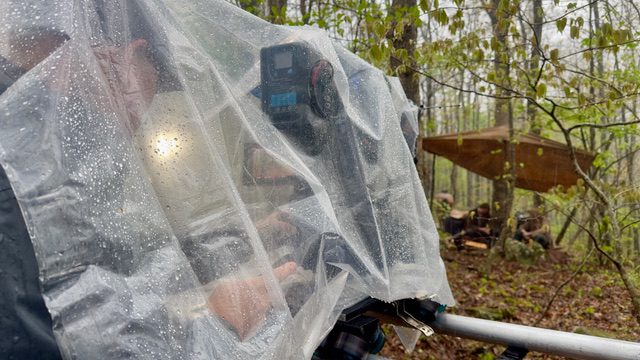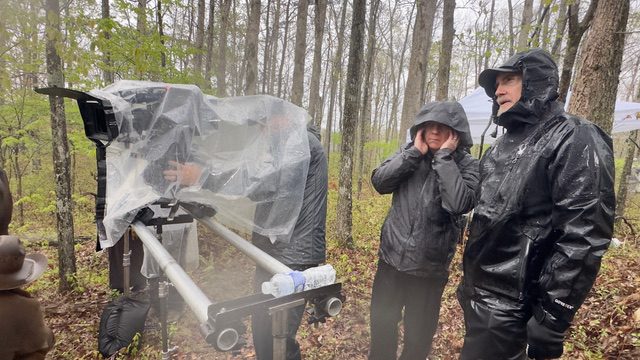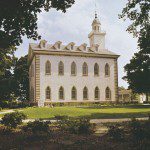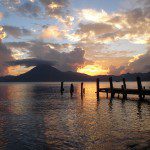
We were back in and around Palmyra today. We filmed at the E. B. Grandin print shop, at the famed intersection that is marked by four large churches (strictly speaking, there are actually five, but there’s only room for four at the, well, four corners), again at the Smith family farm, and on the grounds of the Palmyra New York Temple.
I get a kick out of some of the place names in this area. It seems as if some wandering classicist freely sowed toponyms around the countryside. We’ve driven through towns named Ulysses and Ithaca and Homer and Macedon and Syracuse and Virgil and Marathon and, of course, Palmyra. One of my favorites is the “Hamlet of Egypt,” which, among its other attractions, boasts a place called “Lollypop Park.”
The four large church spires that adorn the main Palmyra intersection — and that have often represented to Latter-day Saints the divisions and confusion caused by the Great Apostasy — are actually on the banners that hang from the lamp posts of the town’s Main Street. Some of us entered into one of them, the former Methodist Episcopal church that stands on what I believe is the northwest corner of the intersection of Main and Canandaigua. The owner of the building very kindly opened the door for us, and we spoke a bit with him. None of the church buildings dates back to the time of Joseph Smith’s residency there, but at least one, the church on the northeast corner, is dated to 1832. The one that we entered goes back to 1866, but its congregation gradually dwindled, the current owner told us, to about ten or fifteen parishioners, and they sold it to him four or five years back. He runs a bed-and-breakfast in an adjacent building on the property and sometimes rents the church out, but now hopes to sell the whole thing in order to move to some property in Ireland that he owns. He believes that the Catholic Church that stands just back from the northeast corner of the intersection — the fifth church — is also dwindling to the point of imminent death.
I did, however, like a little cupboard-like container that stands a few feet to the northeast of the intersection. There were maybe twenty or twenty-five cans of beans and soup and the like in it, and it bore a superscription reading: “Take what you need. Leave what you can.” That’s a nice idea. It could be generalized as a good rule for living, well beyond cans of food.

In the meantime, while I’ve been here in New York on behalf of Scripture Central, the Interpreter Foundation (of which I’m an officer) has been wrapping up the filming of our forthcoming movie Six Days in August in Tennessee and then, at the end, here in the Rochester area. The particular episode of Scripture Central’s series A Marvelous Work in which I’m involved here will, I’m told, probably go up online at the end of May. And, as for Six Days in August, we’re currently looking at sometime in October, though that could change.

College administrators across the country have been very careful in dealing with anti-Israeli and pro-Palestinian protestors on their campuses. They have been trying to avoid confrontations and, in many cases, they have delayed taking any action, while praising the right to dissent and to disagree.
“‘Occupying’ Columbia Protesters Demand Global Intifada, Free Food”
There is at least one issue, however, and at least one group of dangerous protestors, where such dissent simply cannot be tolerated. No “kid-gloves” treatment for these hardened enemies of society! “Middle-School Girls Banned from Track Competition for Protesting Trans Sports Policies”

This week, we have lectures 31, 32, and 33 from Hugh Nibley’s Book of Mormon classes at Brigham Young University, covering Mosiah 7-11.
During 1988, 1989, and 1990, Hugh Nibley taught Honors Book of Mormon classes for four semesters at Brigham Young University. The lectures were video-taped and audio cassettes and printed transcripts were made of the lectures. We believe these recordings will be interesting to listen to and valuable to your Come, Follow Me study program this year. Each week, we will include the lectures covering the Book of Mormon chapters being studied that week.
All 112 lectures are immediately available in PDF, audio, video, and electronic formats, as well as in paperback books that are available for purchase. Links for all of the available online sources can be found in the Complete Bibliography for Hugh Nibley at https://interpreterfoundation.org/bibliographies/hugh-w-nibley/lectures/.
2. The Book of Mormon in Context Lesson 19: “In the Strength of the Lord”: Mosiah 7-10
For the 14 April 2024 Come, Follow Me segment of the Interpreter Radio Show, Terry Hutchinson, Mark Johnson, and Kevin Christensen discussed Book of Mormon lesson 19, “In the Strength of the Lord” covering Mosiah 7-10. That discussion is now available to you — recorded, archived, and liberated from commercial breaks — at your convenience and at no charge. (The other segments of the 14 April 2024 radio show can be accessed at https://interpreterfoundation.org/interpreter-radio-show-april-14-2024.)
The Interpreter Radio Show can be heard, weekly and live (i.e., without a net) on Sunday evenings from 7 to 9 PM (MDT), on K-TALK, AM 1640. Or you can listen to it live on the Internet at ktalkmedia.com.

Finally, here is some horrific news from the Christopher Hitchens Memorial “How Religion Poisons Everything” File™. I hope that your righteous indignation at these outrages will be very gratifying to you:
“Global Youth Service Day Unites Southern California Youth in Acts of Kindness”
Posted from Rochester, New York













